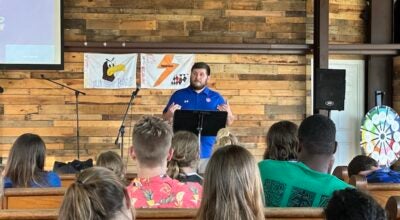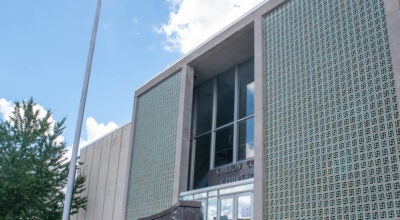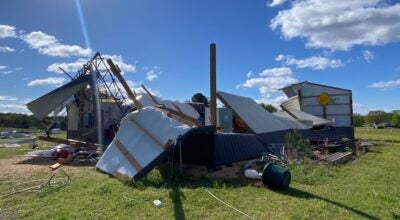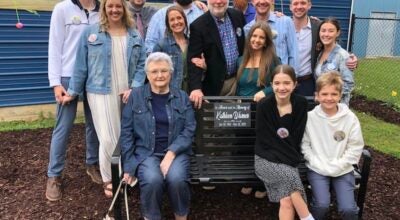Peaches of Chilton Past: How did Chilton County become the ‘peach county’?
Published 2:54 pm Tuesday, July 31, 2018
- Numerous Chilton County residents gathered at Durbin Farms Market for a ribbon cutting for the grand opening of Chilton County’s 2011 Peach Season.
|
Getting your Trinity Audio player ready...
|
Many local industries have made their starts and left their marks on Chilton County soil since establishment of the county — originally Baker County — in December 1868.
Early residents dabbled with corn, cotton and lumber production, and even iron and graphite mines found a place in Chilton County history, before fruit became the cream of the crop for community commerce.
Yet peaches were already here.
As former Union-Banner editor T. E. Wyatt once wrote, “Raising peaches here just comes natural. Our soil and our climate are simply ideal.”
From their presumed natural growth in centuries prior to Chilton County settlement to the peach industry’s peak in 1960 and firmly retained reputation today, peaches have gradually assumed a notoriety that has deemed Chilton County the peach county of Alabama.
Notably, its scepter towers 129 feet above other coveted, Southern peach ground from its dais at Headley’s Big Peach, and a nationally recognized Peach Festival proffers the Chilton County “pride in peaches” annually since 1947, according to the Encyclopedia of Alabama.
But how did it begin? When did the first peach roll across county borders to pursue such a destiny?
The origin is uncertain, but several individuals have proposed possible roots to its renown.
While the earliest local report, “A History of Chilton County” by Clanton Study Club in 1927, references cultivation of peach crops in Thorsby’s early years as a “Northern Colony” established in 1894, other sources pit Chilton County peaches even further in the past.
“Chilton County and Her People: A History of Chilton County, Alabama” compiled by T. E. Wyatt in 1940 and last revised by Carlos W. Wyatt in 1975, indicates that peach growth — prior to commercial peach cultivation — may have existed in present-day Chilton County earlier than 1540.
“History tells us that when Hornando DeSoto and his group of explorers marched down Coosa River in July 1540, there was an Indian town near the mouth of Walnut Creek in what is now Chilton County by the name of Pokana Talahassi,” Wyatt writes.
Wyatt conjectures a peach connection to the name, explaining that the Native American Muscogee language translates the name Pokana Talahassi to “Old Peach Tree Town.”
“There is no way of telling how long before 1540 the ‘Old Peach Tree Town’ received its christening,” Wyatt continued. “It was probably several hundred years old when DeSoto came along. There were peaches, at least peach trees, then.”
If this is true, one might wonder how the Native Americans acquired peaches, a fruit believed to have been domesticated by the Chinese before it diffused to Western Europe and became a high-class delicacy.
Contrary to Wyatt’s assertion, some sources suggest that Spaniards, possibly even DeSoto’s exploration crew itself, were responsible for bringing peaches to the New World.
This would set presumed initiation of Chilton County peach growth back to 1540 at the earliest.
In his conclusion, Wyatt writes, “… to say who started raising peaches in what is now Chilton County would be an impossible task. It was probably an ancestor of McGillivray or Weatherford or Pushmataha, or maybe he had some of the blood of Pocahontas or Will Rogers.”
The answer to the origin of Chilton County’s first peach, then, remains unclear.
However, another question emerges: If peaches existed locally in centuries pre-dating United States history, why did they take so long to rise to distinguishing status on the 701 square miles that comprise Chilton County?
The answer lies in several aspects of the preserved nature of the county: small towns and weather dependency for crops.
Chilton County challenges are as inevitable as its rewards, as fittingly reflected by the peach industry.
When first established, small towns require grunt work and many trial-and-error endeavors to launch and sustain a thriving community. Governments, schools, economy and more must be efficiently established to ensure survival of the society.
The Clanton Study Club reported in 1927, “The first five or six years of Thorsby (1894-1901) were devoted to building and setting out vineyards and orchards, including peaches, apples and plums.”
According to a 2015 Encyclopedia of Alabama article, the Scandinavian-settled Thorsby intensified the peach industry in Chilton County.
Thorsby was dealt a powerful blow in 1914 with the burning of the small town, followed by devastation of crops by insects and disease. Many settlers moved, including founders Theodore Thorson and John Peterson.
This instigated merely a momentary stint to the growth of the Chilton County peach industry.
Clanton peaches and strawberries, among other fruit, joined poultry and dairying as industries of growing importance in Chilton County by 1927.
The introduction of pesticides and crop diversification spurred crop production, for a small period pushing strawberries to the top slot for principal Chilton County crops, according to the encyclopedia.
Peaches took the lead by 1947, just in time for the county’s first Peach Festival hosted in Thorsby.
Numbers plummeted after a late frost in 1955, but peaked five years later “when an estimated 800 producers shipped 478 railroad car lots of peaches grown on 10,000 acres,” the encyclopedia reports.
The market “bottomed out” at about 300,000 bushels in the early 1970s, according to the article.
Reports in 2015 revealed that 71.5 percent of Alabama’s peach production was centered in Chilton County, “with Blount County running a distant second,” the article reads.
“Despite diminishing profits, decreasing acreage, and fewer young people entering the industry, peach growers persist by using improved varieties, production, and marketing practices and by their dedication to a proud tradition,” the article states, referring to the “pride in peaches” Chilton County has faithfully exhibited since at least 1947.
It is here that the answer to the peach’s slow but steady rise to Chilton County renown is revealed: persistence.
To be sure, peach farming is no walk in the park — not even Peach Park. But in Chilton County, it is a proud people who make it possible for travelers to stop and taste the peaches — watering mouths with just a glimpse of the peach water tower.
As relayed by the Encyclopedia of Alabama, “This striking symbol of Alabama’s peach industry demonstrates to passersby that while Georgia might be the peach state, Chilton is the peach county in Alabama.”






